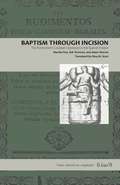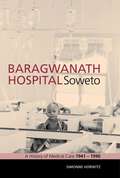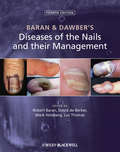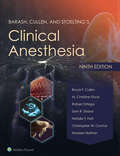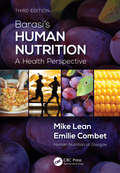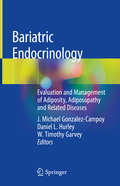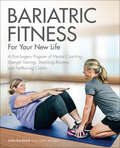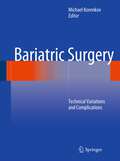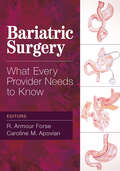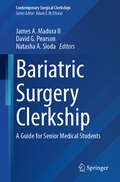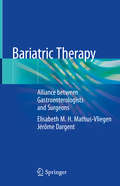- Table View
- List View
Baptism Through Incision: The Postmortem Cesarean Operation in the Spanish Empire (Latin American Originals #15)
by Martha Few Zeb Tortorici Adam WarrenIn 1786, Guatemalan priest Pedro José de Arrese published a work instructing readers on their duty to perform the cesarean operation on the bodies of recently deceased pregnant women in order to extract the fetus while it was still alive. Although the fetus’s long-term survival was desired, the overarching goal was to cleanse the unborn child of original sin and ensure its place in heaven. Baptism Through Incision presents Arrese’s complete treatise—translated here into English for the first time—with a critical introduction and excerpts from related primary source texts.Inspired by priests’ writings published in Spain and Sicily beginning in the mid-eighteenth century, Arrese and writers like him in Peru, Mexico, Alta California, Guatemala, and the Philippines penned local medico-religious manuals and guides for performing the operation and baptism. Comparing these texts to one another and placing them in dialogue with archival cases and print culture references, this book traces the genealogy of the postmortem cesarean operation throughout the Spanish Empire and reconstructs the transatlantic circulation of obstetrical and scientific knowledge around childbirth and reproduction. In doing so, it shows that knowledge about cesarean operations and fetal baptism intersected with local beliefs and quickly became part of the new ideas and scientific-medical advancements circulating broadly among transatlantic Enlightenment cultures.A valuable resource for scholars and students of colonial Latin American history, the history of medicine, and the history of women, reproduction, and childbirth, Baptism Through Incision includes translated excerpts of works by Spanish surgeon Jaime Alcalá y Martínez, Mexican physician Ignacio Segura, and Peruvian friar Francisco González Laguna, as well as late colonial Guatemalan instructions, and newspaper articles published in the Gazeta de México, the Gazeta de Guatemala, and the Mercurio Peruano.
Baptism Through Incision: The Postmortem Cesarean Operation in the Spanish Empire (Latin American Originals)
by Martha Few Zeb Tortorici Adam WarrenIn 1786, Guatemalan priest Pedro José de Arrese published a work instructing readers on their duty to perform the cesarean operation on the bodies of recently deceased pregnant women in order to extract the fetus while it was still alive. Although the fetus’s long-term survival was desired, the overarching goal was to cleanse the unborn child of original sin and ensure its place in heaven. Baptism Through Incision presents Arrese’s complete treatise—translated here into English for the first time—with a critical introduction and excerpts from related primary source texts.Inspired by priests’ writings published in Spain and Sicily beginning in the mid-eighteenth century, Arrese and writers like him in Peru, Mexico, Alta California, Guatemala, and the Philippines penned local medico-religious manuals and guides for performing the operation and baptism. Comparing these texts to one another and placing them in dialogue with archival cases and print culture references, this book traces the genealogy of the postmortem cesarean operation throughout the Spanish Empire and reconstructs the transatlantic circulation of obstetrical and scientific knowledge around childbirth and reproduction. In doing so, it shows that knowledge about cesarean operations and fetal baptism intersected with local beliefs and quickly became part of the new ideas and scientific-medical advancements circulating broadly among transatlantic Enlightenment cultures.A valuable resource for scholars and students of colonial Latin American history, the history of medicine, and the history of women, reproduction, and childbirth, Baptism Through Incision includes translated excerpts of works by Spanish surgeon Jaime Alcalá y Martínez, Mexican physician Ignacio Segura, and Peruvian friar Francisco González Laguna, as well as late colonial Guatemalan instructions, and newspaper articles published in the Gazeta de México, the Gazeta de Guatemala, and the Mercurio Peruano.
Baragwanath Hospital, Soweto: A history of medical care 1941–1990
by Simonne HorwitzBaragwanath Hospital, Soweto illustrates how this rapidly growing, underfunded but surprisingly effective institution found the niche that allowed it to exist, to provide medical care to a massive patient body and at times even to flourish in the apartheid state. The book offers new ways of exploring the history of apartheid, apartheid medicine and health care. The long history of Chris Hani Baragwanath Hospital (its full current name) or Bara, as it’s popularly known, has been shaped by a complex set of conditions. Established in the early 1940s, Bara stands on land purchased by the Cornish immigrant John Albert Baragwanath in the late nineteenth century. He set up a refreshment post, trading store and hotel on the site – in what is now Soweto – which was a one day journey by ox-wagon from Johannesburg. The hotel became affectionately known as ‘Baragwanath Place’ (the surname is Welsh, from ‘bara’ meaning ‘bread’ and ‘gwenith’ meaning’ wheat’). The land was then bought by Corner House Mining Group and later taken over by Crown Mines Ltd. but was never mined. The British government bought the land in the early 1940s to build a military hospital but by 1947, Baragwanath ceased to operate as a military hospital and under the auspices of the Transvaal Provincial Administration a civilian hospital was opened with 480 beds. Patients were transferred from the ‘non-European’ wing of the Johannesburg General Hospital in the ‘white’ area of Johannesburg. Links were immediately forged with the University of the Witwatersrand and Bara would over time become one of its largest teaching centres. This link brought medical students and their teachers into direct contact with apartheid in the medical sphere. This book will contribute to studies of the history of apartheid that have begun to provide a more nuanced account of its workings. The history of Baragwanath and of the doctors and nurses who worked there tells us much about apartheid ideology and practice, as well as resistance to it, in the realm of health care.
Baran and Dawber's Diseases of the Nails and their Management
by Bianca Maria Piraccini Robert Baran Luc Thomas Mark Holzberg David A. de Berker Bertrand RichertThe definitive guide to the science, diagnosis and treatment of all known nail diseases The fifth edition of Baran & Dawber’s Diseases of the Nails and their Management continues to offer an encyclopedic account of the human nail that is unparalleled in its detail and scope. With contributions from some of the world’s leading dermatologists, the book’s exhaustive coverage encompasses the cosmetic and therapeutic management of every form of nail disease. High-quality images and diagrams illustrate and enhance this essential reference guide, while easy-to-navigate sub-chapters help you to find the information you need quickly and accurately. This book: Is edited by Professor Robert Baran – the world’s leading expert on the human nail – together with a team of world-renowned experts from across Europe and North America Provides clinical information on all nail diseases Aids differential diagnosis by color, shape, and location Contains over 1,500 images Includes access to a companion website featuring downloadable images and videos of nail procedures Whether they are new to the field or have been practicing for years, dermatologists, podiatrists, and all of those managing patients with nail diseases should have a copy of Baran & Dawber’s Diseases of the Nails and their Management at their disposal.
Baran and Dawber's Diseases of the Nails and their Management
by Robert Baran Luc Thomas Mark Holzberg David A. de BerkerThe human nail provides a complex structure that supports fine manipulation of objects while protecting the extremities. Diseases of the nail disrupt this function. They can cause pain and discomfort, cause disfigurement and are often unsightly with a profound effect on the sufferer's self confidence. Baran & Dawber's Diseases of the Nails and their Management has long been recognized as the preeminent authority on nail disease. New to this edition is a superb guide to differential diagnosis by color, shape and location within the nail unit to provide rapid clinical information on nail disorders. All thirteen chapters have been thoroughly updated.
Barash, Cullen, and Stoelting's Clinical Anesthesia: eBook without Multimedia
by Bruce F. Cullen Rafael Ortega M. Christine Stock Naveen Nathan Sam R. Sharar Natalie F. Holt Christopher W. ConnorCovering the full spectrum of clinical issues and options in anesthesiology, Barash, Cullen, and Stoelting’s Clinical Anesthesia, Ninth Edition, edited by Drs. Bruce F. Cullen, M. Christine Stock, Rafael Ortega, Sam R. Sharar, Natalie F. Holt, Christopher W. Connor, and Naveen Nathan, provides insightful coverage of pharmacology, physiology, co-existing diseases, and surgical procedures. This award-winning text delivers state-of-the-art content unparalleled in clarity and depth of coverage that equip you to effectively apply today’s standards of care and make optimal clinical decisions on behalf of your patients.
Barasi's Human Nutrition: A Health Perspective, Third Edition
by Emilie Combet Michael EJ LeanBarasi's Human Nutrition: A Health Perspective, Third Edition, provides a comprehensive introduction to the principles and practice of nutrition. Thoroughly revised, restructured, and updated, this new edition presents up-to-date scientific information in an accessible and reader-friendly format, emphasising how important nutrition is for evidence across the full translational health spectrum, from epidemiology and basic sciences through clinical and public heath applications, and ultimately into sustainable public policy. This third edition places more emphasis on applied nutrition than previous editions. Specifically, sections relating to clinical nutrition, public health nutrition, and improving foods for better health are now separate chapters with new chapters on sport nutrition, obesity, and weight management, and each section has a dedicated table of contents to better highlight the subject covered. The book also focuses on nutritional issues related to globally important, potentially preventable, major diseases, such as coronary heart disease, cancer, and diabetes, and discusses methods for studying nutrition and relevant essential dietary principles for intervention. This textbook is written from the perspective of experienced teachers at the undergraduate and graduate levels and is an invaluable resource for students in health and nutrition and for those pursuing further qualifications in food science. While containing substantial detail on some interesting topics, this book is written in an ‘easy-read’ style, which makes potentially complicated subjects accessible to general readers as well as to the more specialised user. It provides both an entry-level introduction to human nutrition for introductory or intermediate undergraduate students and also sufficient comprehensive detail to serve as a reference book for Masters or PhD students.
Barbed Pharyngoplasty and Sleep Disordered Breathing
by Claudio Vicini Fabrizio Salamanca Giannicola IannellaThis book offers a detailed description of the main barbed pharyngoplasty techniques for the treatment of obstructive sleep apnea. These innovative techniques have spread in recent years and are considered as a validated alternative to the classic respective techniques. The book covers the barbed pharyngoplasty selection criteria, the surgical technique, and discusses the post-operative results. It also includes some chapters on the experience of surgical sleep centers in various parts of the world. Written by leading experts in the field of sleep surgery, this book will be interesting for ENT specialists, oral surgeons, maxillo-facial surgeons, plastic surgeons, sleep doctors, neurologists and pneumologists.
Bargaining Power: Health Policymaking from England and New Zealand
by Verna SmithThis monograph applies Kingdon's Multiple Streams Framework to two policymaking episodes of implementing pay for performance in general practice, conducted in England and New Zealand. The Framework's explanatory power for policymaking in Westminster majoritarian jurisdictions is tested and, based on rigorous comparative analysis, recommendations are made for its refinement. The monograph also offers striking lessons for policymakers about how to negotiate successfully with general practitioners.
Bariatric Endocrinology: Evaluation And Management Of Adiposity, Adiposopathy And Related Diseases
by J. Michael Gonzalez-Campoy Daniel L. Hurley W. Timothy GarveyThis unique book – the first ever on bariatric endocrinology – is a comprehensive endocrine and metabolism approach to the diseases that result from excess fat mass accumulation and adipose tissue dysfunction. It takes an approach that places adipose tissue at the center of the clinical approach to patients, as opposed to the complications of adipose tissue accumulation and dysfunction, which has been the dominant approach to date. Initial chapters include discussion of adipose tissue physiology and pathophysiology (adiposopathy), hormonal, central nervous system, and gut microbiome regulation of energy balance and stores, and primary and secondary causes of adipose tissue weight gain. Subsequent chapters cover the evaluation and treatment of dyslipidemia, insulin resistance and hyperglycemic states, hypertension, neoplasia, and gonadal function in men and women. Management strategies, such as nutrition, physical activity, pharmacotherapy, and bariatric procedures, round out the presentation. Each chapter is bookended by bullet-pointed clinical pearls at the beginning and a full reading list at the end. Written and edited by experts in the field of endocrinology and obesity management, Bariatric Endocrinology redefines practice to focus not just on weight loss as measured in pounds lost, but on adipose tissue mass and pathology, decreasing fat mass for adiposity-related diseases and returning adipose tissue to normal function.
Bariatric Endoscopy
by Christopher C. ThompsonTo date, diet programs and medical therapies for the treatment of obesity have had limited success. Bariatric surgery, however, provides a means of effective weight loss for many of those with morbid obesity. Most of these weight loss procedures are performed with a variety of techniques that continue to evolve. Each technique is associated with unique challenges and complications and it is important for the clinician to be knowledgeable about the endoscopic management of these patients. Additionally, as endoscopic technology evolves it may offer more than just the diagnosis and treatment of complications. Endoscopic therapy may soon allow less invasive bariatric revision procedures as well as a variety of primary obesity therapies for various patient populations. Bariatric Endoscopy reviews the management of obesity, normal post-surgical anatomy, endoscopic and medical management of post-surgical complications, and future endoscopic therapies for obesity management. Organized into five sections, the volume covers an obesity overview, traditional therapy, endoscopy and the bariatric patient, medical management of post-surgical complications, and the future role of endoscopy in obesity management. Detailed illustrations are also provided for surgical procedures, complications and obesity management chapters. Authored by authorities in the field, Bariatric Endoscopy is an indispensible tool for the gastroenterologist or surgical endoscopist as they care for patients with complicated bariatric issues.
Bariatric Endoscopy
by Christopher C. ThompsonThe issues presented in this text have particular relevance in our obesogenic society. Over one-third of the adult population in the United States suffers from obesity, and it is now apparent that this epidemic is progressively becoming global in scale. Lifestyle modification, dietary programs, and medical therapies have an important role, however, alone they are not adequate for many patients. Bariatric surgery has provided an effective alternative for achieving durable weight loss in many patients with morbid obesity, and there are currently several types of surgery being employed for weight loss and the treatment of obesity associated comorbid illness. It is estimated that over 200,000 bariatric procedures are performed annually in the United States. The most common are Roux-en-Y gastric bypass and sleeve gastrectomy among others. Each of these surgeries may also have important variations, and are in turn associated with unique gastrointestinal complications. Additionally, there are new medications and emerging endobariatric therapies that are gaining wide acceptance, and offering less invasive alternatives to this struggling population. This textbook on obesity management and bariatric endoscopy is the work of a multidisciplinary group of international experts and is intended to serve as a comprehensive guide to the endoscopic management of patients with obesity. It is divided into three main sections: I. Obesity Overview and Medical Management; II. Traditional Bariatric Surgery and Endoscopic Management of Complications; and III. Endoscopic Bariatric Therapies. Epidemiology, pharmacological and surgical treatment of obesity, surgical anatomy, post-operative complications, endoscopic treatment of complications, and endoscopic bariatric therapies are covered in-depth. In addition to thoroughly revised chapters from the previous edition, the latest volume includes more than 10 new chapters. Clinical gastroenterologists, gastroenterologists in training, and surgeons with a special interest in obesity management will find this book to be of practical importance.
Bariatric Fitness for Your New Life: A Post Surgery Program of Mental Coaching, Strength Training, Stretching Routines and Fat-Burning Cardio
by Julia KarlstadThe first-ever comprehensive guide to exercise after life-changing weight-loss surgeryBariatric surgery is a highly effective way to take control of your weight. But it&’s only one part of the solution. The helpful advice and proven fitness program in this book provide the tools you need to make sure your bariatric surgery produces sustained weight loss.Packed with easy-to-follow instructions and step-by-step photos, Bariatric Fitness for Your New Life informs, educates and outlines functional exercise programs. No matter your current level of fitness, you can dive into these safe weight-loss workouts that include:• Stretching Moves• Cardio Exercises• Yoga Poses• Strength Training• Myofascial Release• Balance Work
Bariatric Plastic Surgery: A Guide to Cosmetic Surgery After Weight Loss
by Thomas B. McNemar John LoMonaco Mitchel D. KriegerA practical guidebook to cosmetic surgery after dramatic weight loss, this book includes information on choosing the right surgeon, what to expect from the surgical procedures, how to manage post-surgical pain, what fees to expect, and how to deal with insurance claims. Before-and-after photos along with detailed illustrations of the surgeries present prospective patients with all the information needed to make fully informed decisions on the procedures.
Bariatric Psychology and Psychiatry
by Alfonso TroisiThis book offers a step-by-step guide to mental health assessment for bariatric surgery patients. A general introduction explains the concepts of bariatric psychology and psychiatry, their relevance in contemporary bariatric surgery, and reasons to include psychologists and psychiatrists in multidisciplinary teams taking care of bariatric patients. The following four chapters address the aspects of mental health that are investigated by bariatric psychology. The psychological processes analyzed here play a major role in influencing patients’ perception of the outcomes of bariatric surgery and in determining their commitment to lifestyle changes and follow-up programs. The second part of the book includes nine chapters addressing the clinical conditions relevant to bariatric psychiatry. For each condition, the major focus is on the impact of psychopathology on bariatric surgery outcomes (weight loss, weight regain, quality of life) and the impact of surgery on its course (remission, worsening, de novo onset). Each chapter in this part includes a discussion of the diagnostic instruments (i.e., structured interviews, clinician-rated tests, and patient-rated tests) that should be used to obtain a valid assessment of the patient’s mental status. Separate chapters focus on psychiatric complications (e.g., suicide and addiction transfer) and psychological problems related to quality of life (e.g., body image dissatisfaction) that may emerge postoperatively. Data on these postsurgery conditions has been reported only recently and, therefore, no published book deals with them. The final chapter offers an overview of unsolved issues in bariatric psychology and psychiatry and reviews emerging research findings that are likely to change assessment and care of bariatric patients’ mental health in the near future. Given its scope—and its wealth of tables, diagrams, mnemonics, and key fact boxes—the book will be an invaluable reference tool for clinicians.
Bariatric Robotic Surgery: A Comprehensive Guide
by Carlos Eduardo Domene Keith C. Kim Ramon Vilallonga Puy Paula VolpeThe present book intends to provide a comprehensive guide to the field of robotic bariatric surgery. It covers all the stages and procedures needed to fulfill credentialing for performing robotic surgery. Also, robotic surgery is presented as an institutional program, and we describe how to establish a robotic program in a hospital environment. The currently accepted and most common procedures – sleeve gastrectomy, gastric bypass and duodenal switch – are described in detail, with a step-by-step description of the techniques, followed by a wealth of photos and videos for each case. Special attention is given to the employment of robotic bariatric surgery in exceptional conditions, such as in super-obese patients, reoperations and revisional procedures. Critical issues, for the success of the robotic surgical interventions, such as anesthesia, are also addressed. Finally, the outcomes of robotic bariatric surgery are described, including long-term weight loss, improvement and resolution of comorbidities and improvement in quality of life. Bariatric Robotic Surgery is the first book specially devoted to this modality of surgical intervention. It is a fundamental tool for surgeons, residents and fellows who want to start a robotic bariatric surgery program. The book also helps experienced robotic surgeons to keep up to date with the various available robotic surgical techniques.
Bariatric Surgery Complications and Emergencies
by Daniel M. HerronThis book provides a concise, focused and clinically relevant summary of complications and emergencies related to bariatric surgery. The first section of the text addresses general complications related to anesthesia and the stress of surgery, including issues such as deep vein thrombosis, pulmonary embolism, hemorrhage, pneumonia and cardiac complications. Additionally, this section addresses the workup of the bariatric patient with abdominal pain. The second portion of the text focuses on gastric bypass and sleeve-specific complications, including staple line and anastomotic leaks, internal hernia, marginal ulceration, GI obstruction, hernia formation and gallstone disease. The third portion of the book examines metabolic, nutritional and psychological complications after bariatric surgery. The text also covers management of weight loss failure. Bariatric Surgery Complications and Emergencies serves as a very useful resource for physicians and surgeons who are involved in any parts of evaluation or management of bariatric patients suffering from postoperative complications or emergencies including bariatric surgeons who perform these operations on a regular basis, non-bariatric general surgeons who cover such patients when on-call, surgical trainees, and primary care physicians.
Bariatric Surgery Complications: The Medical Practitioner’s Essential Guide
by Robin P. BlackstoneThis text provides a background of scientific evidence to understand the complications that occur after bariatric surgery for all providers responsible for care after surgical intervention. Written by experts and based on current peer reviewed literature, the text provides a focused approach to the identification and treatment of bariatric surgery complications. To establish a context for providers, the initial section concentrates on presenting the current procedures as well as risks and expected benefits of each with an emphasis on mechanism of action. It examines the issue of weight regain from the aspect of heterogeneity in order to present the perspective that every procedure has risk of weight regain. The text provides guidance to those front line providers who manage acute emergencies and chronic long term problems. State of the art management of complications like leaks, bleeding, ulcers, blood clots and pneumonia are discussed for all procedures in addition to the management of rapid remission of obesity related disease like Type 2 Diabetes and coagulopathies (Leiden Factor V, Protein C and S) that occur commonly in patients with obesity. Each chapter features a review of the current literature in an easy to reference table format and where appropriate an algorithm to focus the reader on the process of care for any given presenting sign or symptom. Bariatric Surgery Complications will be of great value to fellows in minimally invasive surgery, general surgeons, emergency room physicians, gastroenterologists, primary care physicians, medical students and residents in surgery rotations, integrated health personnel.
Bariatric Surgery Patients: A Nutritional Guide
by Betty Wedman-St Louis"Approximately 65% of our population is overweight and 12% are morbidly obese. This is despite more than 25 years of attempted medical management. Clearly all current efforts have failed to control this enormous problem. Could it be that we have failed to recognize the cause of the disease and therefore have misdirected our efforts?" — Alfredo Fernandez, MD, FASMBS, Surgeon, Tampa, Florida <p><P>Reducing obesity through bariatric surgery provides a sustainable weight loss regimen, because it restricts the size of the stomach and limits food intake. However, the surgery limits the amount of nutrients absorbed by the stomach and small intestine. This book provides a comprehensive, practical guide on pre- and post-nutrition considerations in bariatric patients. It describes surgeries including gastric bypass, lap band, and sleeve; nutrition protocols for surgery patients; pregnancy considerations- pre- and post-surgery; food consumption post-surgery; advancing healthy food intake after surgery; minimizing negative side effects; and recommendations to maintain healthy diet. <p><P>This nutritional guide provides health care practitioners descriptions and answers to the many questions bariatric surgery patients need to know and ask in support group meetings and individual counseling sessions. The first chapter focuses on Selling Obesity and Food as a Cheap and Legal Drug, outlining how food advertising, portion size increases, and food frauds have contributed to the obesity crisis. New research into gut hormones, microbiome influence on obesity, firmicutes, and histamine are included, as well as pregnancy after bariatric surgery and lifestyle changes—eating, sleep, hydration, stress management—needed for success after surgery. <p><P>Many health care practitioners will use the Post Op Discharge Diet stages of progression to explain how the patient needs to prepare for their liquid diet and overcome numerous issues like dumping syndrome, hypoglycemia, and alcohol and caffeine consumption. Diet plans for Ketogenic, Mediterranean DASH, Glycemic, and Low FODMAP are included within this book.
Bariatric Surgery in Clinical Practice (In Clinical Practice)
by Aseem Malhotra David Haslam Matthew S. CapehornThe book is needed for several reasons. Bariatric surgery is one of the most clinically effective and cost effective services in any field of medicine, and is growing in popularity, and the non-specialist family practitioner, allied health professional and pharmacist need to know exactly what it involves. Bariatric surgery is in everyone’s interest – whether medic or patient, as it offers improvement in diabetes, heart disease, sleep apnoea, fatty liver and many cancers, whilst reducing benefits, housing costs and the general burden on the economy. There is a lot of flawed thinking on surgery in primary care, with only a minority of family practitioner specialists making the majority of referrals, whilst many are denying their patients access because of their own misconceived ideas. A ‘back to basics’ book will help tackle the negative views surrounding the topic, and improve the volume and quality of referrals. Very often patients turning up to obesity centres have been given poor advice, and inappropriate treatment, and arrive with little or no idea what to expect. Many medics prioritise other conditions first, overlooking the underlying cause, i.e. obesity. Basic education on obesity and co-morbidities is fast becoming essential.
Bariatric Surgery: Technical Variations and Complications
by Michael KorenkovThe increasing prevalence of obesity in many countries means that it should now be considered a pandemic. It is widely recognized that obesity increases the risk of a variety of life-threatening conditions, including heart disease, diabetes, and hypertension. Bariatric surgery is often the most effective way to treat such morbid obesity. Nevertheless, while various bariatric procedures have been proposed, to date standards have been lacking. In this book, leading experts from around the world discuss all aspects of bariatric surgery and present their own favored versions of surgical procedures with the aid of informative illustrations. Technical nuances are carefully described, and detailed attention is devoted to potential complications and how to avoid them. The expertise of the authors and the range of techniques considered guarantee that both trainees in bariatric surgery and experienced surgeons will find this book to be an invaluable source of information and guidance in their daily work.
Bariatric Surgery: What Every Provider Needs to Know
by Caroline Apovian R. Armour ForseWith obesity levels continuing to rise despite efforts in diet, exercise, and medical management, the focus has now turned to surgery to help combat the obesity epidemic. The operation is just the beginning, and there can be many different complications and side effects associated with weight loss surgery. Bariatric Surgery: What Every Provider Needs to Know takes a multidisciplinary team approach to maximize the patient’s weight loss and to minimize complications, from patient selection to postoperative care. This book was written for any healthcare providers or students involved with bariatric surgical patients to provide them with the important information needed to manage their patient. Drs. R. Armour Forse and Caroline M. Apovian and more than 50 contributors have designed Bariatric Surgery: What Every Provider Needs to Know to provide practical information for non-surgeons and non-nutrition experts who are involved in the care of a patient undergoing bariatric surgery and makes the concepts easy to understand and to apply when caring for a patient with obesity.Bariatric Surgery: What Every Provider Needs to Know covers the fundamental issues that need to be addressed with the overall care of the surgical patient for a multidisciplinary team, including nurse practitioners, physician assistants, gastroenterology residents, dieticians, and medical students. Some topics covered include: Adolescent obesity and weight loss surgery Various surgical procedures such as gastric banding, sleeve gastrectomy, and gastric bypass Anesthetic issues in the patient with obesity undergoing surgery Bariatric surgery and the elderly Immediate postoperative complications Medical management of the patient after bariatric surgery Psychological issues in the bariatric surgery patient
Bariatric Surgery Clerkship: A Guide for Senior Medical Students (Contemporary Surgical Clerkships)
by James A. Madura II David G. Pearson Natasha A. SiodaThis quick-reference guide is the first book written specifically for the many third- and fourth-year medical students rotating on a Bariatric Surgery service. The book focuses on the diagnosis and management of the most common pathologic entities. Each chapter covers history, physical examination, imaging, and common diagnoses. For each diagnosis, the book sets out the typical presentation, options for non-operative and operative management, and expected outcomes. Chapters include key illustrations, quick-reference charts, tables, diagrams, and bulleted lists. Students can read the text from cover to cover to gain a general foundation of knowledge that can be built upon when they begin their rotation, then use specific chapters to review a sub-specialty before starting a new rotation or seeing a patient with a sub-specialty attending. Practical and user-friendly, Bariatric Surgery Clerkship is the ideal, on-the-spot resource for medical studentsand practitioners seeking fast facts on diagnosis and management. Its bullet-pointed outline format makes it a perfect quick-reference, and its content breadth covers the most commonly encountered problems in clinical practice.
Bariatric Surgical Practice Guide: Recommendations
by Saravana Kumar Rachel Maria GomesThis book provides a comprehensive review of literature of various aspects of bariatric surgery arriving at practical recommendations for simplifying day to day practice. This book is divided into 10 sections covering selection of patient, preoperative predictors of outcome, technical considerations, specific situations, post-operative pathways, management of complications, revisional surgery, and perioperative nutritional aspects. It covers specific situations in bariatric surgery such as GERD, hernia repair, gallstone disease, PCOD, NAFLD and end-organ disease. Bariatric Surgical Practice Guide is a quick resource for practicing bariatric surgeons, young and experienced, to understand all practical aspects of this surgery which is gaining importance worldwide at a rapid pace. Recommendations are based on existing literature as well as opinions of the authors who work at state-of-the-art clinical facilities.
Bariatric Therapy: Alliance between Gastroenterologists and Surgeons
by Jérôme Dargent Elisabeth M.H. Mathus-VliegenThis book aims to deepen collaboration between gastroenterologists and surgeons by providing endoscopists and gastroenterologists with a clear understanding of the anatomic alterations likely to be observed after bariatric surgery and acquainting bariatric surgeons with the possibilities offered by endoscopic treatment of obesity itself and of the complications associated with bariatric surgery. The treatment approach in patients with obesity and morbid obesity is usually stepwise, starting with dietary measures, exercise, and behavioral therapy, followed by pharmaceutical therapies, endoscopic bariatric therapy, and, finally, bariatric surgery. Endoscopists and gastroenterologists are involved first because the gastrointestinal tract is affected by obesity-related co-morbidity and second because it provides access for a range of treatment modalities involving endoscopy. Bariatric surgeons may need the assistance of endoscopists and gastroenterologists in the preoperative work-up of patients, in the perioperative period, when acute complications may require an endoscopic intervention, or in the late follow-up period, when complications or insufficient weight loss may be present. This book will be of value for both groups of specialists, enabling them to optimize their cooperation to the benefit of patients.
